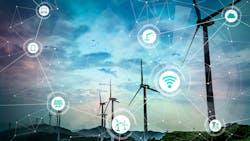DOE Invests US$61 Million for Smart Buildings that Accelerate Renewable Energy Adoption, Grid Resilience
The U.S. Department of Energy (DOE) announced US$61 million for 10 pilot projects that will deploy new technology to transform thousands of homes and workplaces into state-of-the-art, energy-efficient buildings. These Connected Communities can interact with the electrical grid to optimize their energy consumption, which will substantially decrease their carbon emissions and cut energy costs. This project will help achieve the Biden Administration's goal of reaching a net-zero carbon economy by providing a model for reducing the building sector’s contribution to the climate crisis.
“From our homes to workplaces, this groundbreaking, grid-connected building technology will help reduce our impact while cutting energy bills, maximizing convenience, and propelling our efforts to reach a carbon-neutral, clean energy economy by 2050,” said U.S. Secretary of Energy Jennifer M. Granholm. “These projects will help universalize technology that can maximize the efficiency and sustainability of America’s nearly 130 million buildings and make significant headway in the fight against climate change.”
Connected communities of grid-interactive efficient buildings (GEBs) use smart controls, sensors, and analytics to communicate with the electrical grid, reducing the amount of energy they require during periods of peak demand. This capability is used to optimize buildings and distributed energy resources to maintain the comfort of the building occupants, lowers utility bills, and reduces grid system costs.
A recent DOE study estimated that by 2030, GEBs could save up to US$18 billion per year in power system costs and cut 80 million tons of carbon emissions each year. That is more than the annual emissions of 50 medium-sized coal plants or 17 million cars. DOE’s first two connected communities in Alabama and Georgia have already demonstrated this potential by using approximately 42-44% less energy than today’s average all-electric home.
“Lowering energy bills through energy efficiency and energy efficient systems is the best way to lower our carbon emissions and lower costs for businesses, renters, and homeowners," said U.S. Representative Mike Doyle (PA-18). "Developing new technologies to create connected communities that more efficiently move energy around is the type of innovation needed to build an affordable and cleaner energy system for the future, and I am pleased to see an organization from Pittsburgh leading a project at the forefront of this innovation.”
The 10 projects selected today will further demonstrate the capabilities of GEBs across a wider range of technologies, locations, and building types. The teams selected to manage these projects represent a cross-section of the buildings industry that include utilities, local governments, homebuilders, and end-users. Numerous projects plan to bring the economic benefits of GEBs to low-income communities who need it most.
The selectees are:
- Electric Power Research Institute, Inc. (New York City, Seattle, San Diego) will transform multi-family buildings in affordable housing developments into GEBs that will demonstrate different ways to decarbonize buildings, make them more resilient, and reduce utility bills. (Award amount: US$5.27M)
- IBACOS, Inc. (NC) will deploy a coordinated control program to optimize the energy use of a comprehensive mix of distributed energy resources in 1,000 new and existing homes, including single-family and multifamily homes and both owner-occupied and rental properties. (Award amount: US$6.65M)
- Open Market ESCO Limited Liability Company (MA) will bring the benefits of efficiency, demand flexibility, renewable generation, and energy storage with more affordable renovations in up to 20 low-to-moderate-income apartment communities. (Award amount: $6.65M)
- PacifiCorp (UT) will establish a program to manage solar photovoltaic, batteries, electric vehicle charging in a diverse community of all-electric buildings and a mass transit transportation center, equipped with the latest market-leading efficient technologies to optimize their collective energy use and provide grid services at scale.(Award amount: US$6.42M)
- Portland General Electric (OR) will renovate over 500 buildings in North Portland’s historically underserved neighborhoods to reduce their energy burden with numerous energy efficiency measures and connected devices that provide the grid with a range on energy services. (Award amount: US$6.65M)
- Post Road Foundation (ME, NH) will investigate the capacity of a novel Transactive Energy Service System to harmonize communications and optimize energy use among the distributed energy resources, local energy markets, and buildings of three rural communities. (Award amount: US$6.65M)
- Slipstream Group Inc. (WI) will convert approximately 15 facilities in Madison, Wisconsin into GEBs that connect with nearby electric vehicle charging stations to establish a scalable business model for utilities to install demand flexibility and energy efficiency upgrades across multiple building sizes in public and private sectors.(Award amount: US$5.18M)
- Spokane Edo LLC (WA) will unlock demand flexibility up to 2.25 MW using flexible loads in residential and commercial buildings augmented by distributed energy resources within Spokane, Washington’s Opportunity Zones of vulnerable populations. (Award amount: $6.65M)
- SunPower Corporation (CA) will build tomorrow’s homes today in two communities of all-electric homes in Menifee, California that meet DOE’s zero-energy-ready home qualifications and feature solar energy, home energy management systems, and community-scale battery storage. (Award amount: $6.65M)
- The Ohio State University (OH) will investigate the capacity of Ohio State’s existing on-campus connected community to provide essential but overlooked ancillary grid services from a diverse range of grid-interactive technologies in a cyber- and data-secure environment. (Award amount: US$4.2M)
The Connected Communities funding opportunity is led by DOE’s Building Technologies Office in collaboration with the Solar Energy Technologies Office, the Vehicle Technologies Office, the Office of Electricity, and Lawrence Berkeley National Laboratory. Applicants who were not selected through this highly competitive funding opportunity could still be eligible for DOE funding through DOE’s Loan Programs Office, which provides access to debt capital for the commercial scale-up of innovative technologies like grid-interactive efficient building communities.
